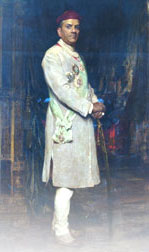History of Vadodara
|

|
Vadodara formerly known as Baroda is the third most populated city in the Indian
State of Gujarat . It is one of the four cities with the population of over 1 million.
Historical and archaeological findings date this place back to the 9th century when
it was a small town called Ankottaka (present Akota) located on the right bank of
the river Vishvamitri (whose name is derived from the great saint Rishi Vishwamitra).
Ankottaka was a famous centre of Jainism in the 5th and 6th century AD. Some of
the Akota bronze images can be seen in the Vadodara Museum . The city was once called
Chandanavati after its ruler Raja Chandan of Dor tribe of Rajputs, who wrested it
from the Jains. The capital had also another name "Virakshetra" or "Virawati" (a
land of warriors). Later on it was known as Vadpatraka or Wadodará, which according
to tradition is a corrupt form of the Sanskrit word Vatodar means 'in the heart
of the banyan tree'. It is now almost impossible to ascertain when the various changes
in the name were made; but early English travellers and merchants mention the town
as Brodera, and it is from this that the name Baroda is derived. Again in 1974 the
name changed to Vadodara.
|
|
Baroda has a rich historical background. The Gaekwads, a Maratha clan who were originally
the generals of Peshwas in Maharashtra, carved out a kingdom for themselves in Baroda
. Damaji's nephew Pilaji became the founder of the house of Gaekwad. The city witnessed
a golden age when Maharajah Sayajirao Gaekwad came to the throne in the late 19th
century. He brought about many reforms in education, medicine, religious tolerance
and administration. Sayajirao was one of the three princes who rated and got a 21
gun salute. It was he who visualised a general scheme of development in all branches
of knowledge at different stages, with the Maharaja Sayajirao University of Baroda
at the apex. Modern Baroda owes its beauty, its educational institutions and its
masterpieces of architecture to the insight and vision of this great ruler.
|
|
There is a saying that nothing grows under the banyan tree, but this is not true
of Baroda . Having witnessed the rise and fall of the empires and kingdoms of the
Hindus, Pathans, Moghuls and Marathas, it now occupies a unique position on the
educational, cultural and industrial map of India . Yet, it has been fortunate enough
to retain the beauty of its rich and varied past. And it is one of the few cities
in India which is still influenced by the lost might of its ruling dynasties.
|
|
Maharaja SayajiRao Gaekwad III (1875-1939) is a legend; he was the adopted son of
Queen Jamnabai. He took Baroda through a golden age with the help of a shrewd statesman
- his chief minister, Diwan Madhav Rao. SayajiRao began constructing the Laxmi Vilas
Palace , naming it after his first wife (a princess of Tanjore).
|
|
Baroda can possess of one of the finest palaces in India . Maharaja Sayajirao Gaekwad
commissioned the famous British Architects, Major Mant and Chisolm to work on Laxmi
Vilas palace. Designed in the Indo-Saracenic style, it is quite a long drive from
the huge created iron gates with the mounted royal emblem, to the entry. The colourful
frescoes in Italian style on the walls of the palace surprise you with their brilliance.
Beautiful statues, marble fountains, Moorish arcades and stained glass windows adorn
the structure.
|
|
The palace is a marvellous work of eclectic architecture, with a mix of all styles.
Built in 720 acres, it was landscaped by Mr Gonderling of Kew . The work started
in 1878 and was completed in 1890; it is still the residence of the royal family.
|
|
The Fatehsinh Rao Museum , located in the palace grounds, houses the royal collection
of paintings, sculptures and other objects of art. Here also existed the Raja Ravi
Verma studio, where he painted some of his famous works which today belong to this
royal family. A garden house which remains shut today and a dargah (mausoleum) also
find place here, (which is also shut); besides a pond with crocodiles. Many cricket
ball and limb were lost here, when those playing cricket close by ventured into
the pond. There is an in-house cricket club too.
|
|
Massive black bulls with blue eyes stand in the doorway leading into the palace
and the grounds, -- real ones, but stuffed ages ago. The gold gilt work on paintings
is a sight to behold; models of the palace can be found under the impressive staircase
leading to the top floor, where the personal chambers of the royal family are located.
Its complicated Darbar Hall has an Italian variety floor and walls with mosaic decorations.
|
|
The convention hall has the entire gamut of carpets, painting, photographs of the
royal family, silver, gold, ivory, furniture, Venetian chandeliers, domes and a
decorous ceiling, There is a huge garden and a Navlakhi Vav which is dry and covered
in creepers said to contain a treasure worth millions, though no one has found it
yet. There is a small mandir by the riverbank Baroda makes for an ideal weekend
getaway spot.
|